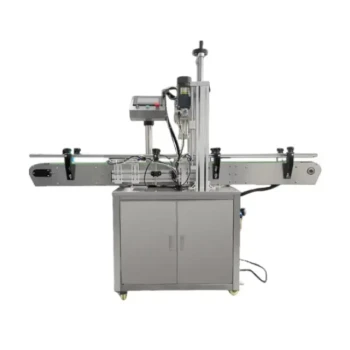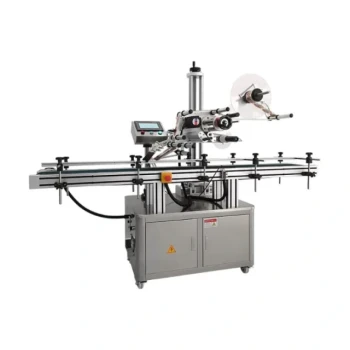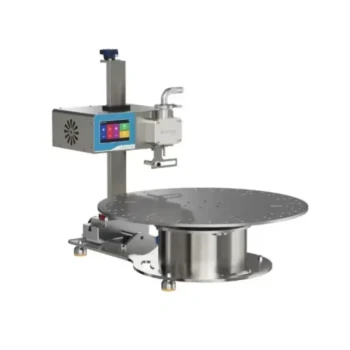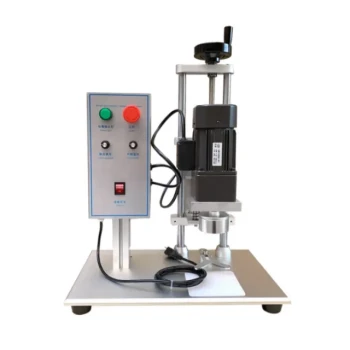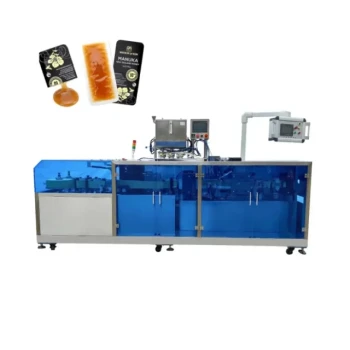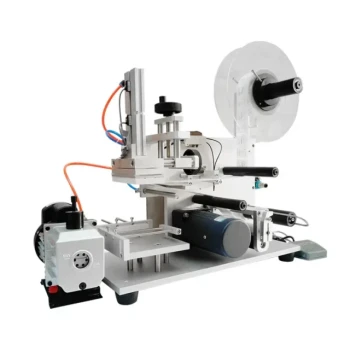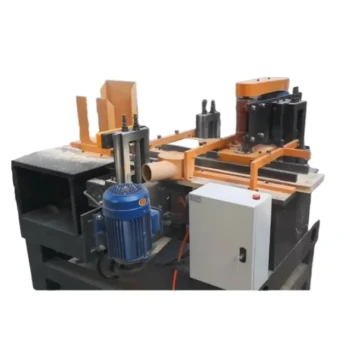The correct machine for packaging honey into sticks or tubes is a vertical form-fill-seal (VFFS) machine, specifically a multi-lane stick pack machine. This equipment is engineered to take a roll of flexible packaging film, form it into narrow tubes, fill them with a precise amount of honey, and then seal and cut them into individual sticks in a continuous, automated process.
The key to successfully packaging honey is not just the machine that forms the stick, but the filling mechanism it uses. Due to honey's high viscosity, a piston filler is the critical component that ensures each stick contains an accurate, consistent, and drip-free dose.

How a Honey Stick Pack Machine Works
A stick pack machine automates the entire packaging process, turning bulk honey and a roll of film into finished, shelf-ready products. The operation is a seamless sequence of three main stages.
Stage 1: Forming the Stick
The process begins with a large roll of flat packaging film, often printed with branding, which is fed into the machine. The machine folds this film around a series of forming tubes, creating the narrow, stick-like shape. The vertical seam is then heat-sealed, creating a continuous tube of packaging.
Stage 2: Filling with Precision
This is the most critical stage for honey. The machine uses a piston filling system connected to a hopper containing the bulk honey. A piston draws a precise, pre-set volume of honey from the hopper and then dispenses it cleanly into each formed stick. This mechanism is essential for handling a thick product like honey without drips or inaccurate measurements.
Stage 3: Sealing and Cutting
Once filled, horizontal sealing jaws clamp down on the tube. They create both the top seal of the filled stick and the bottom seal of the next stick simultaneously. A knife within the jaws then cuts the individual stick free, which drops into a collection bin. This process is repeated across multiple lanes at high speed.
Why Choose Stick Packs for Honey?
While honey is also sold in jars and bottles, stick packs serve a distinct purpose in the market. The format is a strategic choice driven by specific consumer needs and business goals.
Single-Serving Convenience
Stick packs are the ideal format for single-serving, on-the-go consumption. They are perfectly suited for adding to tea, yogurt, or oatmeal in foodservice settings, or for customers who need a portable sweetener.
Minimized Waste and Portion Control
The format provides perfect portion control, minimizing the waste that can occur with larger containers. This makes it a cost-effective choice for both consumers and food service businesses providing amenities.
Lower Material and Shipping Costs
Stick packs use lightweight, flexible film, which is significantly cheaper and lighter than glass jars or rigid plastic bottles. This reduces both material costs and the weight-based costs associated with shipping and distribution.
Understanding the Trade-offs
No packaging solution is perfect for every application. Choosing stick packs involves acknowledging their specific limitations.
Limited Long-Term Protection
While excellent for short-term use, the thin film of a stick pack offers less protection against oxygen and moisture compared to a hermetically sealed glass jar. This makes it less suitable for honey intended for long-term storage or aging.
The Challenge of Product Viscosity
Successfully filling honey sticks is entirely dependent on the right filling technology. Using an inappropriate filler, like a simple gravity filler, will lead to inconsistent volumes, slow production speeds, and messy sealing due to product dripping. A piston filler is non-negotiable.
Equipment Specialization
A stick pack machine is a specialized piece of equipment. It is not as versatile as a standard bottling line, which might be able to handle various container sizes and types. This investment is specific to producing small, flexible pouches.
Making the Right Choice for Your Operation
The decision to use a stick pack machine should be based on a clear analysis of your product goals and target market.
- If your primary focus is on grab-and-go products or food service samples: A multi-lane stick pack machine is the ideal solution for its speed, portion control, and convenience.
- If your primary focus is on long-term retail shelf life and a premium appearance: You should invest in a traditional bottling line for glass jars or PET bottles, which requires piston fillers, capping machines, and labelers.
- If accuracy is your top priority for any package type: Ensure your chosen filling system is a piston filler designed to handle honey's viscosity and deliver consistent, profitable results.
Ultimately, selecting the right machine begins with a clear understanding of your product's final destination and the customer experience you intend to create.
Summary Table:
| Machine Type | Key Feature | Best For |
|---|---|---|
| Multi-Lane Stick Pack Machine | Piston Filling System | Single-serving, on-the-go honey sticks |
| Traditional Bottling Line | Capping & Labeling | Long-term retail shelf life in jars/bottles |
Ready to automate your honey stick production?
HONESTBEE supplies commercial apiaries and distributors with high-performance, wholesale-focused packaging solutions. Our multi-lane stick pack machines with precision piston fillers are engineered to handle honey's viscosity, ensuring accurate fills and maximum efficiency for your operation.
Contact our packaging experts today to discuss the ideal machine for your needs and volume.
Visual Guide

Related Products
- Pneumatic Paste Filling Machine Bottling Packaging Machine Single Nozzle
- Honey Stick Filler Vertical Paste Sachet Packing Machine for Honey Sachets
- Professional Durable Customizable Blister Packing Machine
- Manual Honey Filling Machine Bottling Machine for Honey
- Pneumatic Double Nozzle Honey Filling Bottling Packaging Machine
People Also Ask
- What types of products can semi-automatic filling machines handle? Boost Your Production Versatility
- What features make jar or bottle packing machines suitable for honey packaging? Optimize for Viscosity and Purity
- What are the initial steps to consider when starting a honey processing plant? Build a Resilient Foundation
- What additional support is available for selecting a honey packaging machine? Get Expert Guidance for Your Apiary
- What factors should be considered when selecting a honey packaging machine? Optimize Your Honey Production Line







